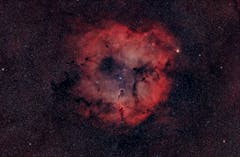Astronomik SII 12nm CCD MaxFR 1.25" (M28.5)
MaxFR Astronomik photographic narrowband-emission line filters for fast optical systems
There is an ever-growing demand for filters suitable for extremely fast optical systems like Celestron's RASA and Takahashi's Epsilon Astrographs.
Our novel MaxFR emission line filters are ideal for very fast focal ratios. The new Astronomik MaxFR series of narrowband emission line filters are perfectly matched for deep-sky imaging with fast optical systems. You can select either 12nm or 6nm bandwidth (FWHM) for oxygen (OIII), hydrogen (H-alpha), and sulfur (SII) emission lines.
Highest transmission:
The Astronomik MaxFR filters are crafted to work flawlessly with fast optical systems. The MFR Coating technique provides optimal out-of-band blocking from UV to IR wavelengths. You get high contrast, minimized stray light, no halos, and needle-sharp stars. These filters give you the best data for processing into stunning final images.
- For 12nm MaxFR filters: Unrestricted usability from f/1.7 to f/8, with around 85% of the maximum transmission guaranteed at f/1.4.
- For 6nm MaxFR filters: Unrestricted usability from f/2.2 to f/8, with approximately 90% of the maximum transmission at f/2 guaranteed.
Imaging with Narrowband Emission Line Filters
If you must observe from light-polluted areas, narrowband emission line filters are excellent for capturing great images. These filters effectively block all forms of light pollution. An H-alpha filter should be your first step into narrowband astrophotography, allowing you to capture deep, high-contrast images even in heavily light-polluted skies or with the full moon in view. OIII filters extend your imaging possibilities by capturing greenish/blueish structures like planetary nebulae and star-forming regions. The SII filter completes the HSO set, giving you the ability to produce images similar to those from the Hubble Space Telescope.
Quality aspects of the new Astronomik MFR narrowband emission line filters:
- MFR Coating: The 12nm filters can be used on all instruments down to f/1.4, while the 6nm filters work down to f/2.
- High-Quality substrate: Made with stress-free, striae-free, optically polished glass. The filter itself consists of ultra-thin layers on this substrate.
- Parfocal filters: All Astronomik Filters are parfocal, meaning the focal plane does not shift when changing filters due to the small thickness tolerance.
- Coating: Astronomik filters have up to 170 layers on both sides of the substrate. These layers act as an anti-reflection coating.
- Durability: Highly scratch-resistant, not sensitive to moisture, and does not degrade over time. Each filter performs optimally and meets specifications even after years of use.
- Integrated Blocking: All unwanted light from UV to IR is blocked, so there's no need for additional UV or IR blockers with these filters.
- Wide range of available sizes: From 1.25" to square 50mm x 50mm filters.
- Delivered in a high-quality protection and storage box.
- Includes a 10-year guarantee thanks to outstanding coating techniques.
Frequently asked questions about Narrowband Emission Line Filters:
- Which full-width-half-maximum (FWHM) is best for me, 12nm or 6nm?
This depends on your equipment and observing site. If your camera has extremely low dark current and effective cooling, the 6nm filters offer major advantages by blocking more background light and allowing longer exposures for deeper images. For DSLRs or dark-current limited cameras, 12nm filters are generally more suitable. The 6nm filters are best for sites with heavy light pollution, low-dark current cameras, and objects requiring maximum contrast and star reduction.
- How much is exposure time increased?
With high transmission (close to 100% at the center wavelength), nearly all emission line photons reach the sensor. However, exposure time can be extended to record fainter structures, as unwanted light from other wavelengths is effectively blocked.
Selecting filters:
Choose the size and FWHM that match your setup for a list of available filters.
















